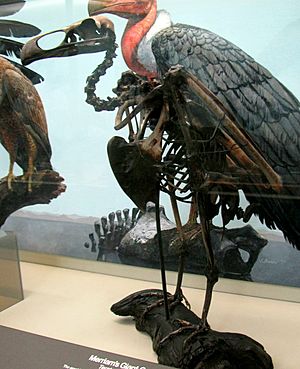Teratorn facts for kids
Quick facts for kids Teratornithidae |
|
|---|---|
 |
|
| Teratornis merriami skeleton from the La Brea tar pits | |
| Scientific classification |
|
| Kingdom: | Animalia |
| Phylum: | Chordata |
| Class: | Aves |
| Order: | Cathartiformes |
| Family: | †Teratornithidae L. H. Miller 1909 |
| Genera | |
|
†Teratornis |
|
Teratorns were a group of very large birds. They were like huge birds of prey. These amazing birds lived in the Americas a long time ago. They lived from the Miocene to Pleistocene periods. All teratorns are now extinct. This means they no longer exist. Some of them were among the largest flying birds ever known!
Contents
About Teratorns
Teratorns belonged to a bird family called Teratornithidae. They lived for millions of years. Their time on Earth ended about 10,000 years ago. Scientists believe teratorns were related to New World vultures. These are the vultures we see today in the Americas.
So far, scientists have found at least five different types of teratorns. These types belong to four main groups, or genera. Each type was unique in its size and where it lived.
Famous Teratorn Species
Two of the most well-known teratorn species are Teratornis merriami and Argentavis magnificens. They show how diverse and huge these ancient birds could be.
Teratornis merriami
Teratornis merriami is the best-known teratorn. Scientists have found over a hundred of its skeletons. Most of these were found in the famous La Brea tar pits. These pits in California trapped many ancient animals.
This bird stood about 75 centimeters (29.5 inches) tall. Its wingspan was about 3.5 to 3.8 meters (11.5 to 12.5 feet). That's like a small car! It weighed around 15 kilograms (33 pounds). This makes it about one-third bigger than today's largest condors. Teratornis merriami became extinct about 10,000 years ago. This was at the end of the Pleistocene period.
Argentavis magnificens
Argentavis magnificens was an enormous teratorn. A part of its skeleton was found in La Pampa, Argentina. This bird is thought to be the largest flying bird that ever lived!
Argentavis magnificens is also the oldest known teratorn. It lived about 6 to 8 million years ago. This was during the late Miocene period. It is one of the few teratorn finds in South America. When it was first found, scientists discovered parts of its skull and wing bones.
Even careful guesses suggest its wingspan was at least 6 meters (20 feet). Some think it might have been as wide as 8 meters (26 feet)! Imagine a bird with wings wider than a school bus! This giant bird was estimated to weigh around 80 kilograms (176 pounds). That's like a small person flying!
See also
 In Spanish: Teratornítidos para niños
In Spanish: Teratornítidos para niños

